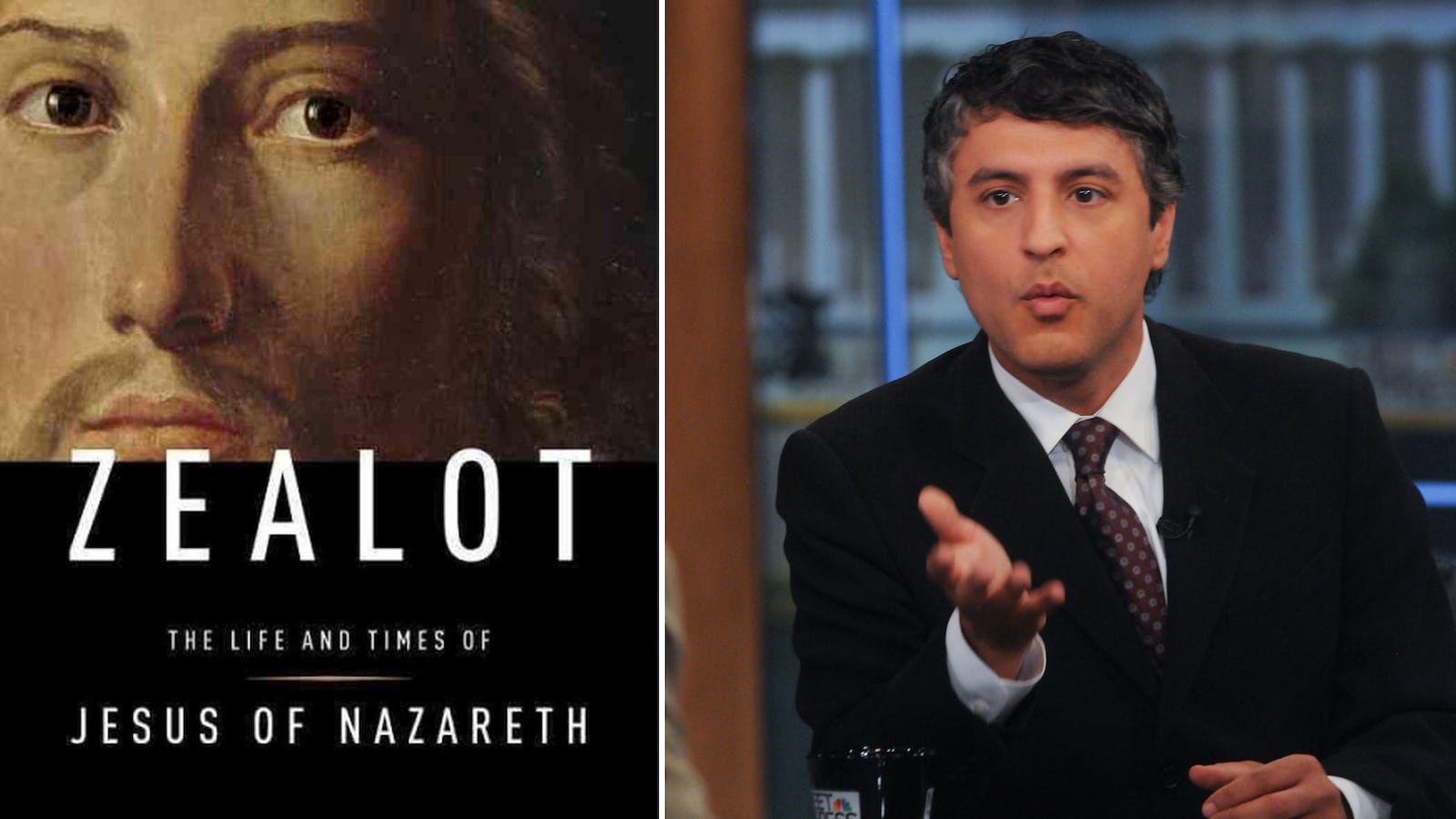By now you have probably already seen one of the most embarrassing interviews in Fox News history: a Muslim scholar’s work is apparently disregarded purely because of his faith. When you sit down to read the book, however, you can see why some Christians have found it so explosive.
We examine the most controversial sections of Reza Aslan’s Zealot: The Life and Times of Jesus of Nazareth.
Perhaps the biggest mistake made by Lauren Green, the Fox News religious correspondent, was failing to challenge any of Aslan’s wilder assertions. He claims Jesus was not born in Bethlehem, was executed as a common criminal, and was more of a rabble-rouser than a man of peace.
Instead, the now viral interview began with Green asking why Aslan, a Muslim, would write a book about Jesus Christ. She proved incapable of moving beyond that misguided line of thinking throughout the entire 10-minute segment, suggesting that his faith prevented him from writing an unbiased academic book on Christianity. She even falsely accused him of hiding the fact that he’s a Muslim (as Azlan calmly clarified to Green, he makes that clear on page two of the book).
The clip became an Internet sensation over the weekend, with BuzzFeed among the first to link to the segment Saturday with the headline: “Is This The Most Embarrassing Interview Fox News Has Ever Done?” New Yorker TV critic Emily Nussbaum tweeted that, indeed, the interview was “absolutely demented,” while The American Conservative called it “cringe-worthy,” “ignorant,” and “breathtakingly incurious,” pointing out that Green showed “zero interest in the book’s argument or content.”
It is most unfortunate for Fox News that Green might as well have copped to not doing her homework before interviewing an author of what was already a top-selling book (No. 8 on Amazon as of Friday). For all we saw, she didn’t so much as read the book jacket. Or, even more embarrassingly, she did and opted to accost Aslan about his religion regardless of the claims in his book. Either way, she unwittingly gave Aslan a huge publicity boost, leaving the rest of us to ask the questions she ignored.

What is Aslan saying about Jesus? How different is the historical Jesus of Nazareth from Christ the religious figure? What were the precise events that led to his crucifixion? And what about those three kings who traveled to Bethlehem to meet the son of God?
Here are the most controversial claims from Zealot:
Jesus wasn’t born in Bethlehem
Few argue that the Nativity is not a lovely story, especially when it’s acted out in church Christmas pageants, complete with Mary, Joseph, and three gift-bearing kings, all in Bethlehem to coo over the newborn son of God. But Aslan writes that this story is simply a magical tale. It appears in the Gospels of Matthew and Luke, but it’s not mentioned by any of the other apostles. (“The name Bethlehem does not appear anywhere else in the entire New Testament, save for a single verse in the gospel of John.”)
Jesus the historical figure was more likely born and raised in Nazareth—an off-the-map village in Galilee, Jerusalem, according to Aslan. “That he came from this tightly enclosed village of a few hundred impoverished Jews may very well be the only fact concerning Jesus’s childhood about which we can be fairly confident,” Aslan writes. Christopher Hitchens and others have noted that Matthew and Luke contradict each other when it comes to Jesus’s genealogy and place of birth.
John the Baptist was once bigger than Jesus
The apostles reinterpreted John the Baptist’s (in)significance in the gospels to make Jesus seem like the one and only messiah, according to Aslan. The scholar Josephus, who witnessed the destruction of Jerusalem, writes in Antiquities that John was put to death by Antipas, a first-century ruler of Galilee and Perea, because he was becoming too popular due to his promises of a new world order—the Kingdom of God. “Many assumed he was the messiah,” writes Aslan, though you would never know it from reading the Gospel. John’s baptism, according to Josephus, was “not for the remission of sins, but for the purification of the body.” But Mark’s Gospel says it was for the “forgiveness of sins” and that John recognized that “there is one coming after me who is stronger than I am, one whose sandals I am not unworthy to untie.” The implication is that Jesus was the “one,” though Mark never explicitly states that. Later Matthew would tell a slightly different story of John the Baptist and Jesus, in which John is the one who asks to be baptized.
So what accounts for these various discrepancies?
According to Aslan: “The problem for the early Christians was that any acceptance of the basic facts of John’s interaction with Jesus would have been a tacit admission that John was, at least at first, a superior figure ... After all, who baptized whom?”
Jesus was a zealot revolutionary
The real Jesus was more like Che Guevara and history’s other famous rabble-rousers than the passive love-thy-neighbor Christ figure in the bible. It’s not clear why Jesus left Nazareth for Judea and John the Baptist, but when he returned, his transformation from craftsman to self-declared prophet was not entirely well received. So he established his ministry in Capernaum, a nearby fishing village, which, like Nazareth, was divided between the haves and the have-nots. The Capernaum have-nots did not know about Jesus’s past life as a craftsman, and they were desperate for a better life.
Aslan writes that Jesus targeted “those who found themselves cast to the fringes of society, whose lives had been disrupted by the social and economic shifts taking place throughout Galilee.” He plucked a select few from the masses to be his disciples (the Gospel of Luke says he had 72 total, though there were only 12 in his inner circle). Like many revolutionaries and religious figures, he was beloved not just for his teachings, but for the charismatic zeal with which he delivered them—“as one with authority and not as the scribes,” according to the Gospels of Matthew, Mark and Luke. Unlike the rich priests, he seemed to a man of the people, a gift from God.
He was crucified for effectively committing a capital offense
When Jesus marched into Jerusalem around A.D. 30, flanked by a chorus of followers singing, “Blessed be the coming kingdom of our father David!” he was announcing himself to the city as the messiah and descendent of David, King of Judah. Then, like a true revolutionary, he forced the city’s vendors out of the temple’s public courtyard—a “blatantly criminal act,” Aslan writes. “After all, an attack on the business of the temple is akin to an attack on the priesty nobility, which, considering the temple’s tangled relationship with Rome, is tantamount to attack on Rome itself.”
With that sweeping gesture, Jesus’s message was simple: the land didn’t belong to Rome but to God, and it was time for Caesar to concede power to Hossana, the real King of Jews. This was sedition and the punishment was crucifixion. The New Testament says Jesus’s crucifixion was a cruelly special punishment for a man who sacrificed himself for humanity’s sins, but history tells us that he was no different from “any other criminal who hangs on a cross.”
Jesus didn’t condone violence, but he didn’t avoid it at all costs, either
Jesus’s aggressive “cleansing” of Jerusalem’s temple is unlike the peacemaking Christ we know from the Bible—the one who invariably loved his neighbors and “turned the other cheek” in the face of violence. For starters, there is no evidence that these references are symbolic to all of mankind, but rather that he was speaking only about his Jewish neighbors and enemies.
Add to this that his entire ministry was constructed around the promise—specifically his promise—of God’s sovereignty on earth, and we can only assume that Jesus expected bloodshed before this foundation for a new world order was laid, Aslan writes. Why else would he have warned his disciples that they, too, would “take up his cross” if they chose to follow him? As Aslan points out, his attempt to hide his “messianic secret” about the Kingdom of God from everyone but his disciples indicates that he knew what was to come—that what he envisioned was “so radical, so dangerous, so revolutionary, that Rome’s only conceivable response would be to arrest and execute them all for sedition.”
We do have plenty of historical accounts of Jesus’s miracles
Jesus helped the blind see anew, healed the infirm, and performed exorcisms. Or at least there are more historical documents claiming he did these things than there are those pertaining to his birth or death. But that says more about the time than it does about this specific miracle worker. Back then, he was one of many magicians wandering the region.
As Aslan puts it: “How one in the modern world views Jesus’s miraculous actions is irrelevant. All that can be known is how the people of his time viewed them. And therein lies the historical evidence.” One thing is true of both Aslan’s Jesus and Christ: neither took payment for performing a miracle.






